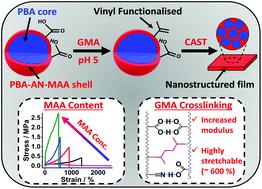当前位置:
X-MOL 学术
›
Polym. Chem.
›
论文详情
Our official English website, www.x-mol.net, welcomes your
feedback! (Note: you will need to create a separate account there.)
Effect of methacrylic acid and pendant vinyl groups on the mechanical properties of highly stretchable core–shell nanostructured films deposited from water
Polymer Chemistry ( IF 4.1 ) Pub Date : 2020-12-17 , DOI: 10.1039/d0py00971g James Turton 1, 2, 3, 4, 5 , Stephen Worrall 5, 6, 7, 8, 9 , Muhamad S. Musa 5, 10, 11 , Amir H. Milani 1, 2, 3, 4, 5 , Yichao Yao 1, 2, 3, 4, 5 , Peter Shaw 5, 10, 11 , David Ring 5, 10, 11 , Brian R. Saunders 1, 2, 3, 4, 5
Polymer Chemistry ( IF 4.1 ) Pub Date : 2020-12-17 , DOI: 10.1039/d0py00971g James Turton 1, 2, 3, 4, 5 , Stephen Worrall 5, 6, 7, 8, 9 , Muhamad S. Musa 5, 10, 11 , Amir H. Milani 1, 2, 3, 4, 5 , Yichao Yao 1, 2, 3, 4, 5 , Peter Shaw 5, 10, 11 , David Ring 5, 10, 11 , Brian R. Saunders 1, 2, 3, 4, 5
Affiliation

|
With the continued drive to develop elastomers, improved methods are required to decrease the environmental impact of their preparation. Previously, such systems used Zn-based salts to form nanostructured ionomeric elastomers which had high modulus values, but only limited stretchability. Here, we investigate highly stretchable, additive-free, nanostructured films that are formed simply by casting aqueous core–shell nanoparticle dispersions and drying. The nanoparticles have a poly(n-butylacrylate) (PBA) core and the shell contains a crosslinked copolymer of BA, acrylonitrile (AN), methacrylic acid (MAA) and 1,4-butanediol diacrylate (BDDA). The nanostructured films are shown to be highly stretchable (up to 1300%) and their toughness increases linearly with MAA content. The latter is due to hydrogen-bonding between the –COOH groups and AN. The core–shell nanoparticles are subsequently functionalised using glycidyl methacrylate (GMA) and the films heated to provide additional covalent crosslinking. We show that the vinyl group content can be evaluated using Raman spectroscopy. The latter also enables the monitoring of nanoparticle functionalisation by the reaction with GMA. Radical coupling of the vinyl groups upon heating of the films is shown to increase both the modulus and toughness of the films. Our new nanostructured films provide an alternative, additive-free, environmentally friendly approach for the preparation of highly stretchable water-based elastomers.
中文翻译:

甲基丙烯酸和乙烯基侧基对水沉积的高拉伸核壳纳米结构薄膜的机械性能的影响
随着开发弹性体的不断努力,需要改进的方法以减少其制备对环境的影响。以前,此类系统使用锌基盐形成具有高模量值,但拉伸能力有限的纳米结构离聚物弹性体。在这里,我们研究了高度可拉伸,无添加剂的纳米结构薄膜,这些薄膜仅通过流延核壳纳米颗粒分散液并干燥而形成。纳米颗粒具有聚(n丙烯酸丁酯(PBA)核和壳包含BA,丙烯腈(AN),甲基丙烯酸(MAA)和1,4-丁二醇二丙烯酸酯(BDDA)的交联共聚物。纳米结构薄膜显示出高度可拉伸性(最高1300%),并且其韧性随MAA含量线性增加。后者是由于–COOH基团与AN之间存在氢键。随后使用甲基丙烯酸缩水甘油酯(GMA)对核-壳纳米粒子进行功能化,并加热薄膜以提供额外的共价交联。我们表明,乙烯基含量可以使用拉曼光谱法进行评估。后者还能够通过与GMA的反应来监控纳米颗粒的功能化。显示了在加热膜时乙烯基的自由基偶联增加了膜的模量和韧性。
更新日期:2020-12-17
中文翻译:

甲基丙烯酸和乙烯基侧基对水沉积的高拉伸核壳纳米结构薄膜的机械性能的影响
随着开发弹性体的不断努力,需要改进的方法以减少其制备对环境的影响。以前,此类系统使用锌基盐形成具有高模量值,但拉伸能力有限的纳米结构离聚物弹性体。在这里,我们研究了高度可拉伸,无添加剂的纳米结构薄膜,这些薄膜仅通过流延核壳纳米颗粒分散液并干燥而形成。纳米颗粒具有聚(n丙烯酸丁酯(PBA)核和壳包含BA,丙烯腈(AN),甲基丙烯酸(MAA)和1,4-丁二醇二丙烯酸酯(BDDA)的交联共聚物。纳米结构薄膜显示出高度可拉伸性(最高1300%),并且其韧性随MAA含量线性增加。后者是由于–COOH基团与AN之间存在氢键。随后使用甲基丙烯酸缩水甘油酯(GMA)对核-壳纳米粒子进行功能化,并加热薄膜以提供额外的共价交联。我们表明,乙烯基含量可以使用拉曼光谱法进行评估。后者还能够通过与GMA的反应来监控纳米颗粒的功能化。显示了在加热膜时乙烯基的自由基偶联增加了膜的模量和韧性。











































 京公网安备 11010802027423号
京公网安备 11010802027423号